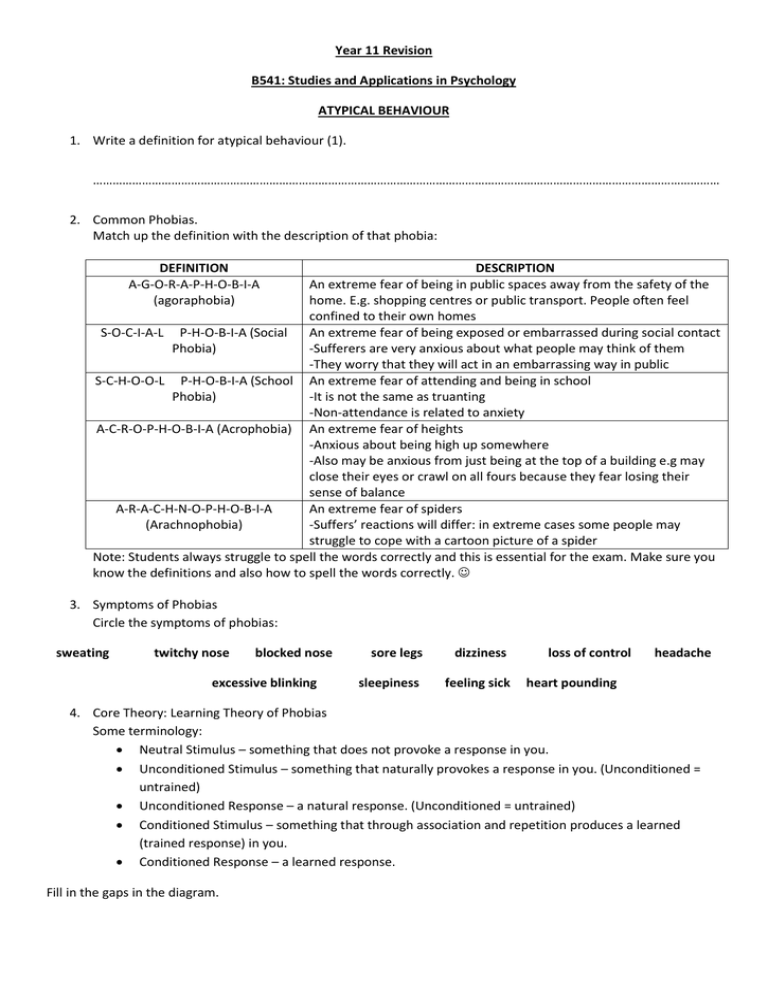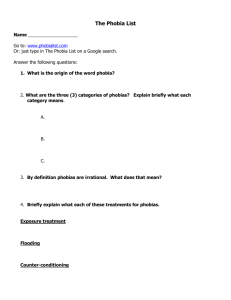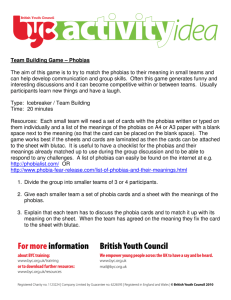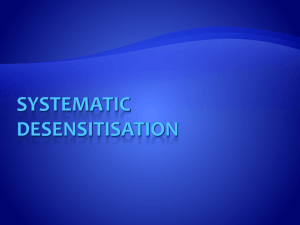here
advertisement

Year 11 Revision B541: Studies and Applications in Psychology ATYPICAL BEHAVIOUR 1. Write a definition for atypical behaviour (1). ………………………………………………………………………………………………………………………………………………………………………… 2. Common Phobias. Match up the definition with the description of that phobia: DEFINITION A-G-O-R-A-P-H-O-B-I-A (agoraphobia) DESCRIPTION An extreme fear of being in public spaces away from the safety of the home. E.g. shopping centres or public transport. People often feel confined to their own homes S-O-C-I-A-L P-H-O-B-I-A (Social An extreme fear of being exposed or embarrassed during social contact Phobia) -Sufferers are very anxious about what people may think of them -They worry that they will act in an embarrassing way in public S-C-H-O-O-L P-H-O-B-I-A (School An extreme fear of attending and being in school Phobia) -It is not the same as truanting -Non-attendance is related to anxiety A-C-R-O-P-H-O-B-I-A (Acrophobia) An extreme fear of heights -Anxious about being high up somewhere -Also may be anxious from just being at the top of a building e.g may close their eyes or crawl on all fours because they fear losing their sense of balance A-R-A-C-H-N-O-P-H-O-B-I-A An extreme fear of spiders (Arachnophobia) -Suffers’ reactions will differ: in extreme cases some people may struggle to cope with a cartoon picture of a spider Note: Students always struggle to spell the words correctly and this is essential for the exam. Make sure you know the definitions and also how to spell the words correctly. 3. Symptoms of Phobias Circle the symptoms of phobias: sweating twitchy nose blocked nose excessive blinking sore legs dizziness sleepiness feeling sick loss of control headache heart pounding 4. Core Theory: Learning Theory of Phobias Some terminology: Neutral Stimulus – something that does not provoke a response in you. Unconditioned Stimulus – something that naturally provokes a response in you. (Unconditioned = untrained) Unconditioned Response – a natural response. (Unconditioned = untrained) Conditioned Stimulus – something that through association and repetition produces a learned (trained response) in you. Conditioned Response – a learned response. Fill in the gaps in the diagram. Classical Conditioning Being stung (unconditioned stimulus) may cause a fear response (unconditioned response) because it could cause you pain. If it is a bee that stings you, then you could associate the stinging with the actual bee. Before this event a bee might see quite harmless (neutral stimulus). Through repetition and association the bee becomes a conditioned stimulus because it triggers a conditioned response (fear). Operant Conditioning Operant conditioning is also used by ………………………………… to explain phobias. It is learning by…………………….. . If the consequences are …………………………… we learn to do them …………………… but if they are negative we tend not to ………………….. the action. This can explain why phobias ……………………. and we do not lose them. For example, why do people not learn that not every bee is going to sting them? We only learn this when we ………………… our fears. Many do not face their …………………. because avoiding the fear is rewarding, so they keep on avoiding the …………………….. or situation. If they do try to face their fear it will result in………………………. As anxiety is ………………………….people won’t want to face their fear again. anxiety Behaviourists punishing object rewarding repeat continue consequences again fears 5. Evaluating the Core Theory (AO2) Colour code the sentences to make the correct PEELS. face Point Evidence Explanation Elaboration P- One criticism of the behaviourist theory of atypical behaviour is that it only focuses on behaviour and ignores the mind and thinking behind behaviour. E- For example, people can learn their phobias from imitating and observing their role models. E- This suggests that two people can have the same experience but may not form the same associations, so the thinking behind behaviour is important. L- This weakens the credibility and explanatory power of the behaviourist explanation of atypical behaviour. P- Another criticism of the behaviourist explanation of atypical behaviour is that phobias can be learnt through indirect experiences such as social learning. E- For example, a number of British people have a phobia of snakes even though they are unlikely to have come across one. E- So if a parent hides under the stairs during a thunderstorm, a child may copy this behaviour and develop a phobia of storms too. The child has not formed a phobia through association but through social learning. L- This weakens the credibility of the behaviourist theory for explaining atypical behaviour. P- A final criticism of the behaviourist explanation of atypical behaviour is that it cannot explain how some people have phobias of objects and situations that they have no direct experience of. E- For example, two people may have been attacked on a dark night. One person may think about it rationally and realise that they are unlikely to be a victim of an attack again. However, another person may think irrationally, decide they are likely to get attacked again and may develop a phobia. E- This suggests that some phobias are more to do with nature rather than nurture and people are simply born with them. L- This weakens the credibility of the behaviourist theory for explaining atypical behaviour. 6. Alternative Theory of Phobias: EVOLUTIONARY THEORY Highlight the key words: Preparedness to fear certain objects or situations is something that has evolved over thousands of years. Our ancestors may have been seriously under threat from animals such as snakes and spiders in their day. People in the past who feared these things were more likely to survive. These are the people who also managed to reproduce as well. In reproducing, they passed on their preparedness of certain fears. These fears or a preparedness to fear have been inherited by each new generation. 7. Core Study: Watson and Rayner (1920) True or False? a. b. c. d. e. f. g. The participant in the experiment was called little Freddie. Watson and Rayner used a lab experiment to investigate how phobias develop. Little Albert was 11 months old. At first everything they tested on Albert scared him (e.g. burning paper or animals). The only stimuli that triggered a natural fear was a fire alarm. They conditioned albert to fear a white rat. They did this by pairing the white rat with a loud bang from a hammer hitting a steel bar. h. They paired the neutral stimuli (rat) with the unconditioned stimuli (loud bang) 327 times. i. Albert became scared of the white rat because he learned to associate it with a loud bang. True True True True True True True False False False False False False False True False True False 8. Core Study AO2 Fill in the gaps: a. One weakness of Watson and Rayner’s study is that it lacks …………………….. validity. This is because the research was conducted in a highly …………………………….. environment (a lab setting). The research was therefore carried out in an artificial setting. This means that the researchers may have shown that you can condition a phobia in a laboratory but they did not show it can happen in a more ……………………. setting. Therefore, the findings cannot be ……………………………….. to a real life setting because individuals would act differently in the real world. This means that the ………………………….. of the research is weakened as it lacks applicability. credibility Ecological natural generalised controlled b. Another weakness of Watson and Rayner’s study is that a small ………………………. size was used (lack population validity). This is a problem because the sample consisted of only ……………….. baby who was 11 months old. This means that we do not know whether it would be easier or more difficult to condition other………………………... We also do not know whether it would be possible to condition phobias in older children or adults. Consequently, the results of the study cannot be ………………………….. to the wider population which means the ………………………….. theory being tested by Watson and Rayner lacks explanatory………………………………. power Sample one Behaviourist children generalised c. A final …………………………… of Watson and Rayner’s study is that there are a number of reasons why it is highly…………………………... For example, Albert was clearly caused …………………………….. as he was made afraid of white rats and there was no attempt to …………………………….. the phobia. In addition, Albert could have been left with a …………………………… disorder for life and was therefore psychologically……………………. Although this was unethical research, a ……………………………………………… would have been conducted beforehand. This would be to establish if the potential costs (i.e. psychological harm) would outweigh the benefits (in this case, finding out if phobias can be learnt). If they do not, the research would go ahead. As a consequence, it can be said that although Watson and Rayner’s study does break ethical…………………………, it still provides ……………………………….. insight into forming phobias. guideline valuable distress counter-condition mental cost benefit analysis Weakness unethical 9. Real Life Applications: Answer the questions about therapies used to cure phobias. a. Flooding: Give an example of curing someone with a fear of flying through flooding. What is the theory behind flooding? What will initially happen to clients? What will happen after some time being faced with their fear? b. Systematic Desensitisation: What do patients and therapists need to form at the start of their therapy? Give an example of systematic desensitisation for a patient with arachnophobia. c. Implosion Therapy: Which therapy is implosion therapy similar to? Why is implosion therapy more ethical? harmed



